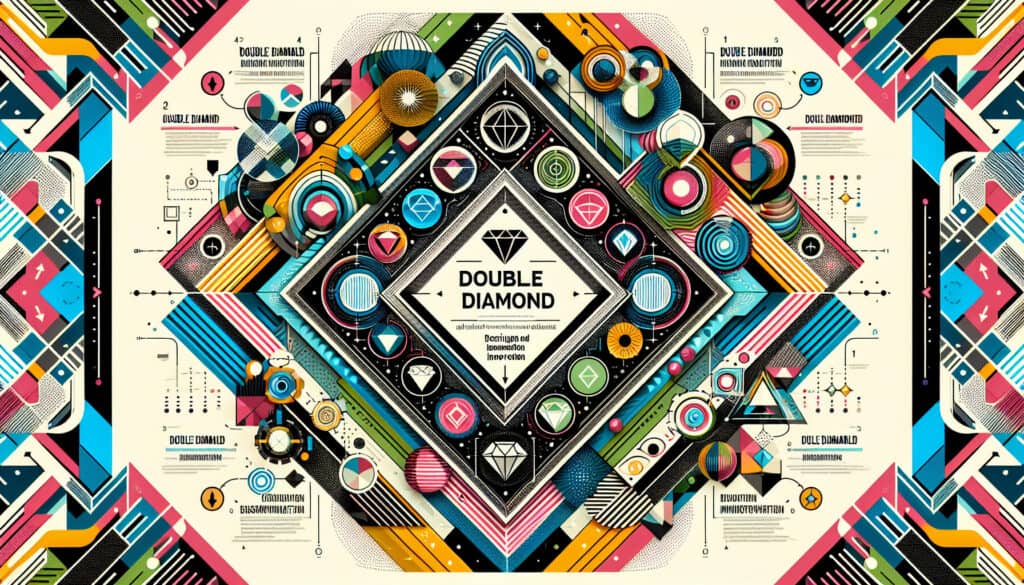A model that visualizes the design and innovation process, breaking it down into four distinct phases.
- Methodologien: Maschinenbau, Ergonomie
Double Diamond

Double Diamond
- Agile Methodik, Kreativität, Funktionsübergreifende Zusammenarbeit, Entwurfsprozess, Design Denken, Design-Validierung, Innovation, Prototyping, Benutzerzentriertes Design
Zielsetzung:
Wie es verwendet wird:
- Developed by the UK's Design Council, it consists of two diamonds. The first diamond is about exploring the problem (Discover, Define) and the second is about creating the solution (Develop, Deliver). Each diamond involves a phase of divergent thinking followed by a phase of convergent thinking.
Vorteile
- Provides a clear and simple map of the creative process; helps teams to understand where they are and what they should be focusing on; emphasizes the importance of understanding the problem before creating a solution.
Nachteile
- Can be an oversimplification of the often messy and non-linear reality of the design process; teams may apply it too rigidly.
Kategorien:
- Ideenfindung, Problemlösung, Produktdesign, Projektmanagement
Am besten geeignet für:
- Structuring the design process by first exploring the problem widely (diverge) and then focusing on a clear problem definition (converge), before creating and testing solutions.
The Double Diamond methodology is particularly advantageous in sectors such as product design, architecture, software development, and engineering, as it establishes a structured framework for addressing both broad and specific challenges. In the Discover phase, teams engage in various activities such as user interviews, market research, and competitor analysis, enabling them to gather a wide array of information that illuminates the core issues at hand. This phase is often driven by multidisciplinary teams comprising designers, engineers, marketers, and users to ensure diverse perspectives. During the Define phase, the insights collected help to crystallize the problem statement, allowing teams to focus on a specific challenge that needs addressing. As teams transition to the Develop phase, they rapidly generate multiple concepts through brainstorming sessions, prototyping, and user testing, fostering innovation by encouraging iteration based on user feedback. This experimentation often occurs in industries like consumer electronics and automotive, where real-time testing of prototypes can significantly influence design decisions. Finally, the Deliver phase involves finalizing the product or solution, which may include aspects like marketing strategies and product launch activities. In this phase, collaboration between designers, engineers, and marketing teams is often vital to ensure a coherent and appealing offering in the market. The Double Diamond methodology aligns well with agile practices, as it encourages regular review and adjustment, allowing teams to be responsive to changing user needs and market dynamics throughout the design and development cycles.
Die wichtigsten Schritte dieser Methodik
- Conduct extensive research to understand user needs and market context.
- Identify and articulate the core problems or challenges based on insights.
- Develop a clear problem statement that guides the design efforts.
- Generate a wide array of ideas and potential solutions through brainstorming.
- Prototype the most promising ideas to visualize solutions.
- Test prototypes with users to gather feedback and identify improvements.
- Refine solutions based on user feedback and iterate as needed.
- Implement solutions, ensuring they align with user needs and business goals.
- Launch the final product and monitor its performance in the market.
Profi-Tipps
- Involve multidisciplinary teams during the Discover phase to enhance understanding of the problem from various angles and expertise.
- Utilize iterative prototyping in the Develop phase, allowing frequent refinements based on user feedback to improve the design progressively.
- Establish clear metrics for success during the Define phase, ensuring that all team members are aligned on objectives and can measure the effectiveness of solutions.
Verschiedene Methoden lesen und vergleichen, Wir empfehlen die
> Umfassendes Methoden-Repository <
zusammen mit den über 400 anderen Methoden.
Ihre Kommentare zu dieser Methodik oder zusätzliche Informationen sind willkommen auf der Kommentarbereich unten ↓ , sowie alle ingenieursbezogenen Ideen oder Links.
Historischer Kontext
1949
1950
1950
1960
1960
1960
1960
1940
1950
1950
1958
1960
1960
1960
1960
(wenn das Datum nicht bekannt oder nicht relevant ist, z. B. "Strömungsmechanik", wird eine gerundete Schätzung des bemerkenswerten Erscheinens angegeben)















Verwandte Artikel
Fragebögen zu muskuloskelettalen Beschwerden
Multivariate Tests (MVT)
Mehrfache Regressionsanalyse
Motion-Capture-Systeme
MoSCoW-Methode
Moods Median-Test